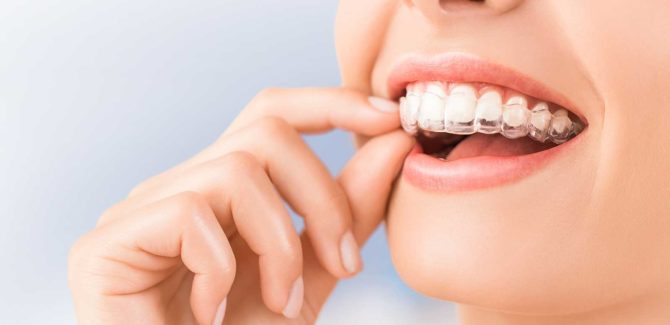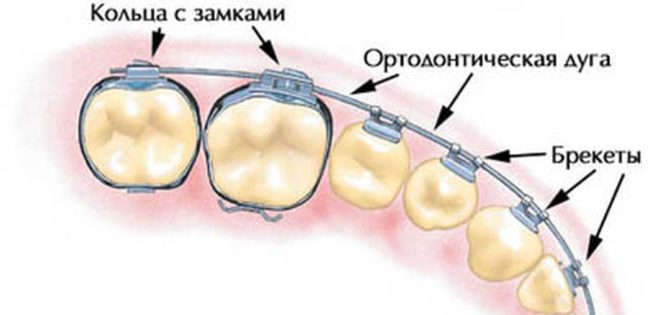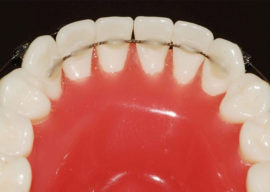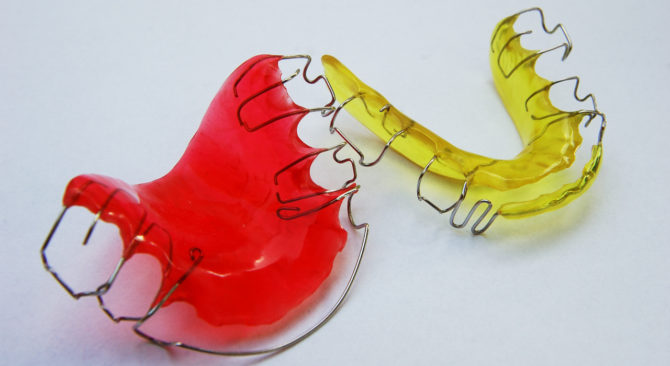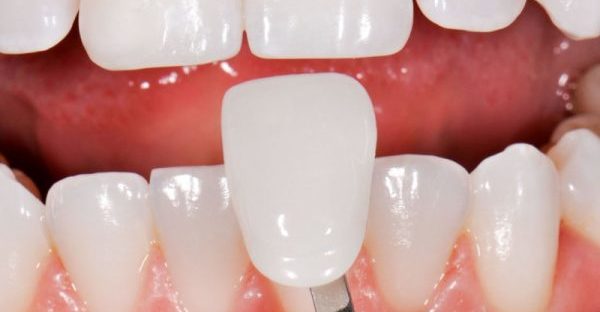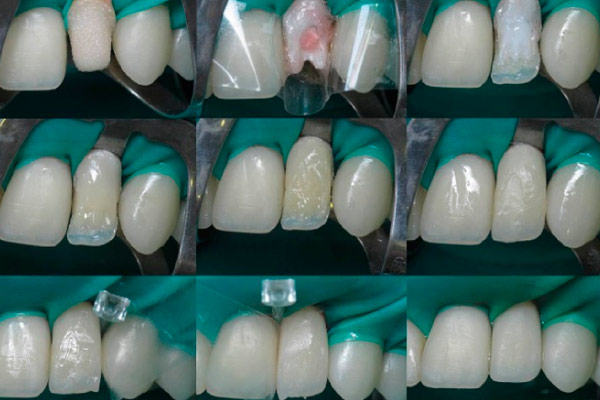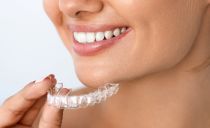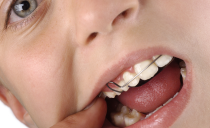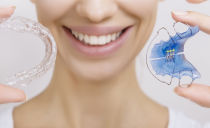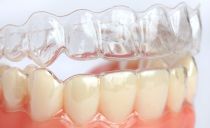How to align front and chewing teeth without braces in children and adults
If you start to struggle with malocclusion at a young age, in the worst case, orthodontic treatment will last a year and a half. Adults have more difficulties, because the older the person, the less effective the parentheses become. The problem is also that not everyone wants to wear them and therefore are looking for alternatives. You can align your teeth without braces, however, from all available methods, it is necessary to choose the best for a particular person, since they are not suitable for everyone.
Content
Features of orthodontic treatment in children and adults
It is easiest to correct the bite for children 5-12 years old, since at this age the jaw bones are extremely malleable for correction. A suitable method of orthodontic treatment is chosen by the dentist, taking into account the causes of the anomaly, the physiological characteristics of the child's development, and the wishes of the parents.
For example, trainers are not suitable for talkative babies, if there are bad habits (nail biting), lip bumpers are needed, plates are recommended for correcting only front teeth, and braces are recommended for significant defects.
Only by the age of 16–17 does the human root system strengthen. Prior to this, it is still mobile, so it is much easier to correct malocclusion and curvature of dental crowns. However, not only this distinguishes tooth alignment in adults:
- A more serious load is used, otherwise it will be impossible to straighten the bite of the teeth and straighten the row.
- Before installing orthodontic brackets, it is sometimes necessary to remove one or more molars that do not fit in a row.
- After the teeth have aligned and the bite has returned to normal, a long recovery and prevention period begins. Without it, the bite will quickly take its original shape.
- Sensitization of enamel and gums is a frequent side effect.
- In adulthood, complex treatment is often used, combining several techniques at once.
All these factors only complicate treatment in adulthood, but do not make it impossible. Even if correction of teeth and bite with braces is difficult, correction and micro prosthetics are always available.
Treatment of malocclusion and straightening teeth with braces
The bracket system is the main tool of the orthodontist. It is used to solve even the most serious problems with bite and curvature.
The main element of the braces is an arc made of nitinol, an alloy of titanium and nickel. This material has a “shape memory". The nitinol arch is given a look that corresponds to the patient's even dentition, then it is tempered and cooled. In the future, the arc will take its original shape regardless of the degree of deformation. If the arch is correctly installed, it will exert constant pressure on the entire dentition. The curves of the front and rear teeth will gradually begin to shift and “stand up” evenly.
In the oral cavity, the arc is fixed using special clamps - rings with locks. Throughout the arc are placed "rectifying" elements - braces. They cling to all bent teeth, they can be installed both on the outer and inner sides of the row.
Orthodontic braces are most often made of metal. But recently, other materials have been no less actively used - ceramics, artificial sapphire and even plastic.
The duration of braces treatment depends on the complexity of the problem. The minimum wearing period is 6 months, with the most serious malocclusion and marked curvature, treatment can last up to 2.5 years.
Is it possible to straighten teeth without braces
Today you can put brackets that will be completely invisible to others, but such a system is expensive, so many adults tend to align their teeth with themselves and their children without braces.
Both adults and children can really straighten their teeth without braces, but orthodontists prescribe such a treatment only in the following cases:
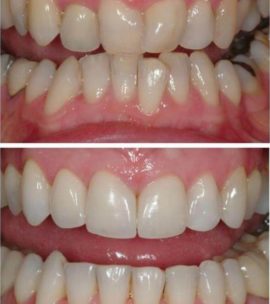 It is necessary to eliminate a slight curvature, as in the photo on the right.
It is necessary to eliminate a slight curvature, as in the photo on the right.- There are no serious problems with occlusion and occlusion disorders (jaw closure). Only brackets will help to fix such defects.
- The patient is allergic to metal, which is why conventional treatment is not possible.
- A low gum line at which dental correction with braces is not possible.
- Low pain threshold at which conventional treatment will bring many problems.
- It will be difficult for a person to observe the mandatory rules for the care of braces.
- Work or lifestyle requires impeccable appearance and diction.
Another reason for using alternative methods of bite correction can be considered the lack of time for treatment, when the patient needs the result as quickly as possible. Then you can straighten your teeth without braces with the help of restoration.
Methods of teeth alignment without braces in children and adults
There are several methods for straightening teeth in adults and children without the use of braces. Some of them relate to orthodontics, while others relate to prosthetics. The first group includes retainers, trainers and aligners, the second group includes veneers and composite restoration.
Teeth alignment retainers
To fix crooked teeth without braces and eliminate bite problems, dentists most often recommend using a retainer. It resembles brackets in many ways: its design also uses an arc made of nitinol, which evens out crowns and corrects bite. Only the arc is fixed in a slightly different way.
There are two types of retainers - removable and non-removable. Removable retainers are also known as plates. In addition to the arc, in their design there is a base made of plastic, which follows the line of the gums and the sky. A fixed retainer consists of an arc and several brackets with which it is attached to the back of the teeth.
Typically, both types of retainers are used after braces, but with a slight curvature of the dentition, they can be used separately. Moreover, the non-removable retainer is very effective when installed on the lower jaw, and the plate on the upper.
Fixed retainer teeth line up for several years. All this time, the patient cannot remove the structure and therefore simply gets used to it. With the plate, everything is somewhat more complicated: it can be removed before eating and cleaning, the rest of the time it should remain in the mouth.
In both cases, treatment can be delayed for 5-6 years, and we are talking about those problems that braces cope with in months. Given that the fixed retainer is not visible at all, and the plate can be removed at any time, many still find this leveling method more convenient.
Adults are more likely to wear transparent removable retainers. For children, special colored products are made (see photo), which allow to attract the attention of the baby and interest him in correcting the bite.
Trainers for aligning teeth
Trainers in appearance and principle of operation are a bit like plates.They are mainly used to eliminate problems with bite in children or as an auxiliary construction for fixing the result after braces are applied by adults, but sometimes they are used to solve other orthodontic problems:
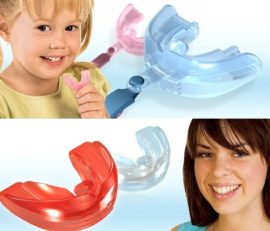 Orthodontists recommend wearing trainers when you need to correct serious problems with a bite, which led to atrophy of some muscles in the jaw and oral cavity. The design in this case is used as an auxiliary simulator.
Orthodontists recommend wearing trainers when you need to correct serious problems with a bite, which led to atrophy of some muscles in the jaw and oral cavity. The design in this case is used as an auxiliary simulator.- Trainers wear overnight people with hypersensitivity or those who have recently placed braces and are not used to them. The system prevents the friction of the elements of the brackets on the mucosa.
- More trainers are used to correct the bite. They train the muscles of the jaw, make the person breathe correctly and help keep the tongue in the right position - that is, the device fights the root causes of the wrong bite.
- For a slight correction of the curvature of the teeth without the use of braces, a system of two trainers is used - blue and red. First, a person wears a blue trainer (6–8 months). It is more elastic and puts less pressure on incisors, fangs and molars. The red trainer is quite tough, they have been wearing it for more than a year - during this time the series is noticeably aligned.
In order to straighten the teeth and improve the bite, the trainer is put on all night and for another 2-3 hours during the day. The longer the patient wears the device, the faster the result will be visible.
Aligners for aligning teeth
Eliners - These are silicone or plastic mouthguards that almost completely repeat the dentition. They work on the same principle as previous products: the mouthpiece presses on the teeth and slowly straightens them.
Eliners cannot replace braces when aligning a bite and strongly bent teeth in adults. They cope only with minor anomalies and malocclusion in children under 15 years of age.
This design has a lot of advantages over other orthodontic methods:
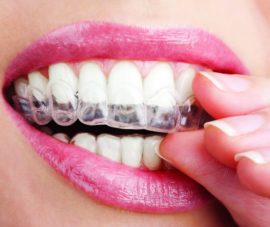 Elayner transparent and invisible to others.
Elayner transparent and invisible to others.- They are easy to remove during meals.
- The design can align one or two teeth in just 5-6 months.
- Oral hygiene does not suffer in any way.
- In the process of straightening incisors and canines, bleaching can also be carried out.
- No changes in diet.
- No pain.
- There are no contraindications.
Eliners wear no less than 22 hours a day. You can remove them only with food and hygiene procedures. The dentist makes for the patient immediately 10-20 cap. You need to wear them in the correct order, since the shape of each design is different and corresponds to a separate leveling step.
The main disadvantage of eliners is the high price. In Moscow and St. Petersburg, 200–250 thousand rubles must be paid for such a system.
Adult veneers
Installation of veneers is already a cardinal solution to the problem, which does not apply to orthodontics, but to orthopedic dentistry. Designs allow you to align your teeth as quickly as possible, as they simply hide the problem from others.
Veneers are thin plates made of ceramic, which perfectly repeats the appearance of human enamel. For convenience of fixing in the lower part of the plate is a kind of pocket or groove. Before installing the design, the top layer of natural enamel must be removed. Then, using special glue, veneers are fixed to the front of the teeth.
Ceramic plates help in cases where only the front teeth need to be aligned, and there are no complex problems with curvature and bite. Dentists do not advise resorting to such a method of correcting teeth without special need, since it will not be possible to restore the turned enamel. More veneers will have to be periodically changed - about once every 10 years. Therefore, consult with an orthodontist first.
Composite restoration for dental alignment in adults
Veneers are not suitable in cases where a person’s teeth do not bulge, but rather go beyond the main line of the row. Still, this solution is not suitable for low tissue mineralization. Such adult patients may be advised to straighten their teeth using composite restoration.
The essence of the method lies in the fact that after a special treatment a composition is applied to a hard fabric, which hardens under the influence of ultraviolet light. Almost the same cement is used for filling.
Advantages of composite restoration:
- Faster effect. An experienced specialist can make you perfect teeth in just one day.
- It can be used as a temporary measure, because you don’t have to grind enamel much.
- Restoration will cost several times cheaper than other ways to align crooked teeth.
To carry out the restoration, the dentist using a composite composition forms an even dentition. Then it dries and polishes the material. In the end, it’s even difficult to understand exactly where the restored teeth are located.
Composite composition is not as durable as ceramic. Under the influence of bacteria and saliva, it is destroyed within 5-6 years, after this period it will be necessary to repeat the procedure or choose another solution to the problem.
Smooth teeth without braces are real, but all available methods have a lot of disadvantages. Some methods give insignificant results, others are too expensive, and still others completely spoil your teeth. Therefore, it is better to resort to such treatment only when the use of brackets is really difficult.

